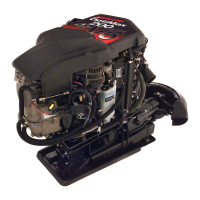
 Loading...
Loading...
Do you have a question about the Mercury 200 SportJet and is the answer not in the manual?
| Model | 200 |
|---|---|
| Horsepower | 200 |
| Kilowatts | 149.1 |
| Full throttle RPM range | 5150–5650 |
| Idle speed RPM range | 900–1000 |
| Number of cylinders | 6 |
| Piston displacement | 2508 cc (153 in³) |
| Cylinder bore | 88.4 mm (3.500 in.) |
| Stroke | 67.3 mm (2.650 in.) |
| Spark plug | NGK IZFR6J‑11 |
| Spark plug gap | 1.1 mm (.043 in.) |
| Recommended gasoline | Refer to Fuel and Oil |
| Recommended oil | Refer to Fuel and Oil |
| Emission control system | Electronic engine control (EC) |
| Battery rating (minimum) | 1000 marine cranking amps (MCA) or 800 cold cranking amps (CCA) |
| Charging system output | 60 A |